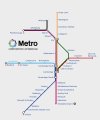William3000
Member
Following the proposal for the Cornwall Metro
Which cities or towns could lend themselves to a metro type service based on a core city or town in a way that could significantly increase passenger usage without having major operational knock on effects?
Southampton and Exeter seem possible contenders with an advanced suburban rail network
Norwich another using mainly existing infrastructure with some new stations, increased frequencies, etc
Line 1: Bittern Line - Norwich to Cromer/Sheringham half hourly (possible new stations at Broadland Business Park and Rackheath) - longer term extension to Holt on heritage line?
Line 2: North Wherry Line - Norwich to Great Yarmouth via Acle half hourly (possible new station at Postwick Park & Ride)
Line 3: North Wherry Line (Berney Arms branch) - Norwich to Great Yarmouth via Reedham (2 hourly)
Line 4: South Wherry Line - Norwich to Lowestoft half hourly with new station at Postwick and additional platform at Oulton Broad North for East Suffolk Line
Line 5: Breckland Line - hourly to Thetford in addition to existing longer distance services but with new east facing bay at Thetford. Then hourly services calling at Norwich Trowse, Hethersett, Wymondham, Spooner Row, Attleborough, Eccles Road, Harling Road, and Thetford. Eccles Rd, Harling Row, Spooner Row would no longer serve Cambridge/Stansted AirPort trains which would continue to stop at Wymondham and Attleborough.
Line 6: Mid Norfolk Line - Norwich to Dereham hourly with trains calling at Norwich Trowse, Hethersett, Wymondham, Thuxton, and Dereham. Non heritage services wouldn’t stop at Wymondham Abbey, Kimberley Park, or Thuxton.
Which cities or towns could lend themselves to a metro type service based on a core city or town in a way that could significantly increase passenger usage without having major operational knock on effects?
Southampton and Exeter seem possible contenders with an advanced suburban rail network
Norwich another using mainly existing infrastructure with some new stations, increased frequencies, etc
Line 1: Bittern Line - Norwich to Cromer/Sheringham half hourly (possible new stations at Broadland Business Park and Rackheath) - longer term extension to Holt on heritage line?
Line 2: North Wherry Line - Norwich to Great Yarmouth via Acle half hourly (possible new station at Postwick Park & Ride)
Line 3: North Wherry Line (Berney Arms branch) - Norwich to Great Yarmouth via Reedham (2 hourly)
Line 4: South Wherry Line - Norwich to Lowestoft half hourly with new station at Postwick and additional platform at Oulton Broad North for East Suffolk Line
Line 5: Breckland Line - hourly to Thetford in addition to existing longer distance services but with new east facing bay at Thetford. Then hourly services calling at Norwich Trowse, Hethersett, Wymondham, Spooner Row, Attleborough, Eccles Road, Harling Road, and Thetford. Eccles Rd, Harling Row, Spooner Row would no longer serve Cambridge/Stansted AirPort trains which would continue to stop at Wymondham and Attleborough.
Line 6: Mid Norfolk Line - Norwich to Dereham hourly with trains calling at Norwich Trowse, Hethersett, Wymondham, Thuxton, and Dereham. Non heritage services wouldn’t stop at Wymondham Abbey, Kimberley Park, or Thuxton.

